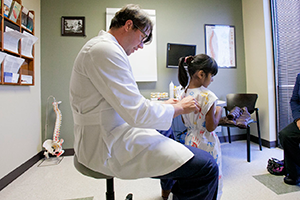
Learn more about the providers at Texas Spine and Scoliosis, the only spine specialized neurosurgery, orthopedic surgery, and non-surgical rehabilitation group in the central Texas area.
 Most of the time the patient is unaware of the curvature in their spine until it is noticed by someone else. Some of the warning signs to look for are shoulders at different heights, appearance of a uneven waist, rib cages at different heights, leaning of entire body, fatigue, backache, low-back pain and head not aligned with the pelvis. These signs and symptoms typically begin in adolescence when boys and girls hit their growth spurt.
Most of the time the patient is unaware of the curvature in their spine until it is noticed by someone else. Some of the warning signs to look for are shoulders at different heights, appearance of a uneven waist, rib cages at different heights, leaning of entire body, fatigue, backache, low-back pain and head not aligned with the pelvis. These signs and symptoms typically begin in adolescence when boys and girls hit their growth spurt.
Boys and girls develop mild scoliosis around the same rate, but interestingly, girls have an increased risk of the scoliosis worsening. Severe scoliosis — a curve greater than 100 degrees — can create dangerous problems. The spinal curve can encroach upon the lungs and heart, as well as other organs, making it more difficult to breathe and for the heart to pump blood flow properly.
If there is uncertainty that you or your child might have scoliosis, you should see a scoliosis specialist to get evaluated. School examinations include Adam’s Forward Bend Test for scoliosis. This test has the child bend over and touch their toes, which exposes the spine to the examiner so he or she can easily detect any abnormal spinal curvatures. Additional testing can be done by taking an X-ray from the front and the side to get a clearer view of the spine’s alignment. A scoliosis specialist will monitor the patient over several follow up visits to compare the results of the previous visits to get a better idea of the pace of the progression of the spinal curve.
The treatment of scoliosis is based on the severity of the curve and the potential of the spine to curve even worse. Scoliosis treatment involves observation, bracing, and in severe cases where the curve is worsening, surgery. The first step is to observe if the curve is worsening or staying the same over time.
A custom back brace may be used to prevent worsening of the spinal curve, rather than to reverse the curve. Scoliosis experts caution the patient and the parent that at best, a brace may slow a curve, which may make corrective surgery less complex.
It’s important to note that the majority of children diagnosed with scoliosis will not need any type of treatment. Only about one in seven adolescents diagnosed with scoliosis will ever need to begin some type of treatment whether that be bracing or surgery. Early detection is key to prevent a surgery, or make correction surgery less complex.

For adults, scoliosis over time can cause discs to herniate from the pressure placed on them from the curve. Another complication can be osteoporosis, where the vertebrae in the spine become porous and brittle, causing vertebral fractures. This can limit the surgical treatment options.
When surgery is necessary, the concern with adults is that the older the patient, the less the flexible the spine is for correction, and the more risk for spinal cord damage during correction. In this case, waiting years to deal with progressing scoliotic curves can be a disadvantage.
Surgery consists of using metal rods, screws or wires to de-rotate the curve. An incision is made in the back so the surgeon can access the vertebrae and install the necessary instrumentation, rods, hooks and screws.
Scoliosis surgery is based on a two-rod instrumentation system with hooks that attach to each vertebral level, to de-rotate and straighten the abnormal curve.
Over the last five years, new minimally invasive scoliosis surgery has emerged that enables a scoliosis surgeon to make several shorter incisions to access and straighten the spine, rather than one long incision. This enables the patient to have a faster and less painful recovery.
The good news about scoliosis is that the vast majority of people diagnosed with some degree of scoliosis will often live normal, active and healthy lives.
Texas Spine and Scoliosis is a regional referral center for the treatment of back and neck pain and scoliosis

Learn more about the providers at Texas Spine and Scoliosis, the only spine specialized neurosurgery, orthopedic surgery, and non-surgical rehabilitation group in the central Texas area.
 Texas Spine & Scoliosis approved for the new BRAIVE scoliosis tethering study
Texas Spine & Scoliosis approved for the new BRAIVE scoliosis tethering study

Read about various patient success stories that have been performed by the physicians at Ascension Texas Spine & Scoliosis